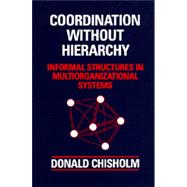
Note: Supplemental materials are not guaranteed with Rental or Used book purchases.
Purchase Benefits
Looking to rent a book? Rent Coordination Without Hierarchy [ISBN: 9780520080379] for the semester, quarter, and short term or search our site for other textbooks by Chisholm, Donald William. Renting a textbook can save you up to 90% from the cost of buying.
| List of Tables, Figures, and Maps | p. ix |
| Preface | p. xi |
| Multiorganizational Systems | p. 1 |
| Reorganization and Coordination | p. 6 |
| Decomposability and Organizational Structure | p. 9 |
| Informal Organization and Loosely Coupled Systems | p. 11 |
| Theoretical Perspectives on Organization | p. 14 |
| Formal Failures and Informal Compensations | p. 20 |
| The Informal Organization: Planned or Spontaneous? | p. 24 |
| Failures in the Process of Coordination | p. 28 |
| The Multiorganizational Setting | p. 35 |
| The Problem of Interdependence | p. 40 |
| Basic Premises | p. 41 |
| Operations, Services, and Planning in Bay Area Public Transit | p. 44 |
| Bilateral and Multilateral Interdependence | p. 52 |
| Origins of Bilateral and Multilateral Interdependence | p. 58 |
| Conclusion | p. 63 |
| Informal Coordinative Mechanisms | p. 64 |
| Formal Failures and Informal Channels | p. 65 |
| Informal Channels and Informal Networks | p. 69 |
| Informal Network and Subsets | p. 78 |
| Informal Conventions and Norms | p. 85 |
| Cosmopolitanism and Coordination | p. 89 |
| The Fruits of Informal Coordination | p. 93 |
| The Grant Application Process and the Busbridge Agreement | p. 94 |
| The Transbay Tube Fire and Its Aftermath | p. 99 |
| Coordination in Operations and Services | p. 104 |
| Factors Facilitating Informal Organization | p. 112 |
| The Norm of Reciprocity | p. 114 |
| System Properties | p. 120 |
| Organizational Properties | p. 126 |
| Personal Attributes | p. 132 |
| Other Factors: Serendipitous Propinquity | p. 135 |
| Conclusion | p. 136 |
| Informal Weaknesses and Formal Compensations | p. 137 |
| The Personal Nature of Informal Organization | p. 138 |
| Enforceability, Time, and Accountability | p. 142 |
| Interdependence and the Multiorganizational System | p. 146 |
| A Hybrid System of Coordination: The Role of the RTA | p. 150 |
| A Hybrid System of Coordination: The Role of MTC | p. 154 |
| Conclusion | p. 159 |
| Coordination and Tradeoffs with Other Goals | p. 160 |
| Differences in Operating Environment | p. 162 |
| Consistency, Goal Displacement, and Institutionalization | p. 169 |
| Representation | p. 173 |
| Reliability | p. 182 |
| Conclusion | p. 186 |
| Conclusion | p. 188 |
| Unnecessary Surgery | p. 188 |
| Limits to Informal Coordination | p. 192 |
| Problems, Expectations, and Satisfactory Coordination | p. 197 |
| An Afterword | p. 203 |
| Changes | p. 204 |
| Coordination Activities | p. 206 |
| MTC as Coordinator and Regional Representative | p. 211 |
| A Final Note | p. 213 |
| Appendices | p. 215 |
| Notes | p. 225 |
| Bibliography | p. 245 |
| Index | p. 265 |
| Table of Contents provided by Syndetics. All Rights Reserved. |
The New copy of this book will include any supplemental materials advertised. Please check the title of the book to determine if it should include any access cards, study guides, lab manuals, CDs, etc.
The Used, Rental and eBook copies of this book are not guaranteed to include any supplemental materials. Typically, only the book itself is included. This is true even if the title states it includes any access cards, study guides, lab manuals, CDs, etc.